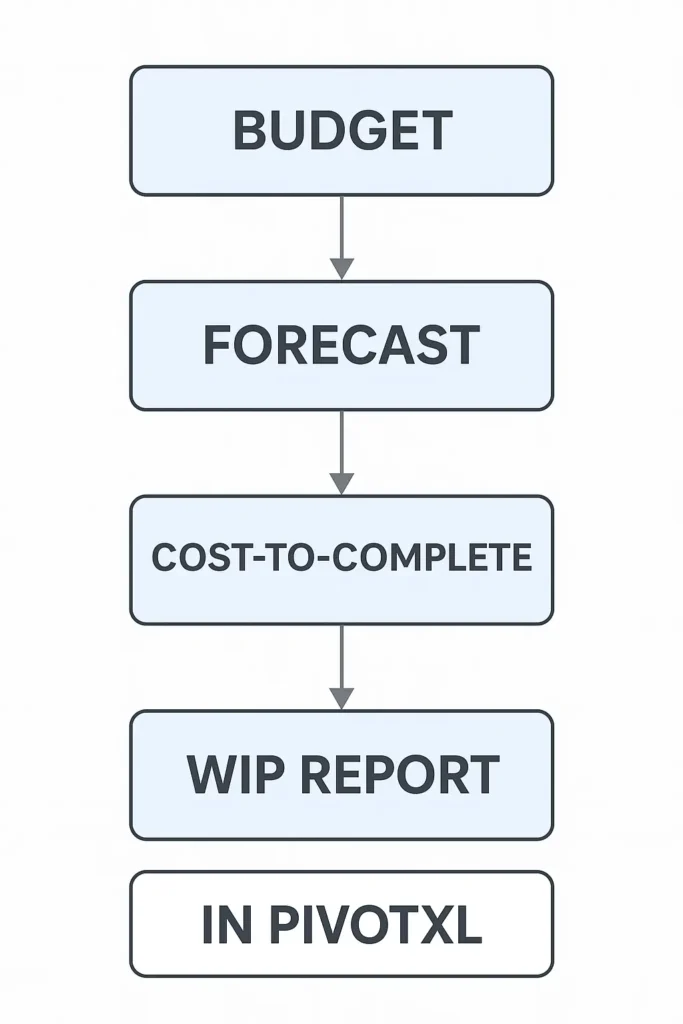Forecasting is not just a “nice-to-have” in construction—it is critical. Every project moves through dozens of cost and schedule changes before completion. Without ongoing, accurate forecasts, it’s almost impossible to know whether the project will finish on budget or meet financial expectations.
In construction finance, forecasting connects three key areas:
- The original budget.
- Cost-to-Complete (CTC) calculations.
- Work-in-Progress (WIP) reporting for stakeholders and bonding companies.
When these three areas stay connected and up to date, decision-making becomes faster, more accurate, and far more strategic.
Why Forecasting Matters in Construction
Forecasting looks forward and answers the question: “If things continue the way they are, how will this project end financially?”
To answer that, forecasting:
- Analyzes actual costs already incurred.
- Estimates remaining costs for labor, materials, and subcontractors.
- Factors in risks like change orders, weather delays, or price increases.
- Compares results to the original budget to see if the project is still on track.
With accurate forecasts, construction companies can:
- Plan cash flow and funding more effectively.
- Spot overruns before they become unmanageable.
- Improve trust with owners, bonding companies, and banks.
- Make decisions that protect or even improve project margins.
Without reliable forecasts, WIP reports may show outdated or misleading information—making it difficult to manage risk.
Forecasting + Cost-to-Complete = WIP Accuracy
Forecasting and CTC are two sides of the same coin.
- Cost-to-Complete tells you the money needed to finish a job from today’s point forward.
- Forecasting takes that CTC figure and projects the total cost at completion, comparing it to the budget.
- WIP reporting uses these numbers to calculate the percentage of completion, earned revenue, and profit-to-date.
When they work together:
- WIP reports are accurate and reflect current realities.
- Overbilling and underbilling risks drop.
- Executives have reliable data to guide decisions.
Common Challenges with Traditional Methods
Many construction firms still rely on Excel-based forecasting. While Excel offers flexibility and familiarity, it also introduces challenges:
- Manual work – Someone has to gather job cost data, re-enter it into spreadsheets, and update multiple files.
- High error risk – A broken formula or missed row can lead to incorrect numbers.
- Data delays – By the time a WIP report is generated, the numbers may already be outdated.
- Lack of integration – Forecasts, CTC, and WIP often live in separate files, making it hard to see the full picture.
Even companies with ERP systems like Sage 100 Contractor, Sage 300 CRE, CMiC, or Viewpoint Spectrum face these issues. Their ERP holds actuals and budgets, but forecasting tools inside the ERP can be rigid, leading teams to export data back to Excel for flexibility.
From Budgeting to Forecasting: The PivotXL Advantage
In our earlier post on construction budgeting software, we explained how budgeting and WIP reporting can be automated while keeping the familiar Excel environment. Forecasting is the natural next step in that process.
With PivotXL, forecasting becomes a connected, real-time process:
- Seamless Excel Integration – Keep using your own templates, but link them to a structured central database.
- Automated Forecasting & CTC – Combine budgets, actuals, and forecasted amounts in one place. Updates flow instantly to CTC and WIP calculations.
- Real-Time WIP Reporting – Pull live job cost data from your ERP and produce ASC 606-compliant reports without re-keying data.
- Scenario Modeling – Test the financial impact of delays, change orders, or material cost changes in minutes.
- Collaborative Updates – Project managers can enter their CTC and forecast data directly into connected Excel templates. Finance teams see those updates immediately without email exchanges.
The Forecasting Workflow with PivotXL
Here’s how a construction forecasting process works inside PivotXL:
- Pull Actuals from Your ERP – Connect directly to job cost data so you’re always starting with up-to-date figures.
- Enter Forecasts & CTC – Project managers input their best estimates for remaining costs in Excel templates linked to PivotXL.
- Automated Calculations – The system updates CTC, percent complete, and projected final cost in real time.
- Generate WIP Reports – Create clean, audit-ready WIP schedules with a single click, formatted exactly how stakeholders need.
- Analyze & Act – Use built-in variance reports and scenario tools to adjust plans before overruns become unavoidable.

Why This Matters for Project Profitability
Forecasting isn’t just about compliance—it’s about protecting profit margins.
- Accurate forecasts reveal margin erosion early, giving teams time to correct course.
- Live integration with WIP ensures owners and bonding companies receive transparent, current information.
- Combined with budgeting, forecasting creates a closed loop where plans and actual performance are always aligned.
Final Word
Forecasting is the strategic heart of construction financial control. When combined with Cost-to-Complete and WIP reporting, it forms a complete system for tracking and guiding project success.
We’ve already shown how budgeting fits into the process. Now, forecasting brings that budget to life—constantly updating the plan, feeding accurate CTC, and ensuring WIP reports reflect the real state of each project.
With PivotXL, you can keep the Excel flexibility your teams love while automating the flow of information from budgeting through forecasting and into WIP reporting—making sure every number is accurate, timely, and actionable.



